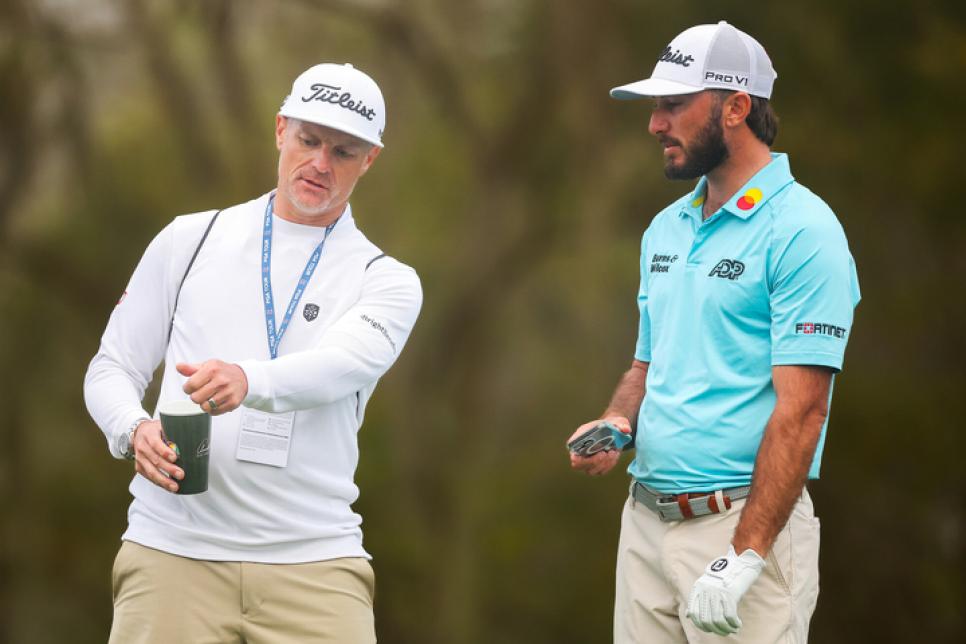You don’t have to be a coach or a player to sense the difference in tone on a PGA Tour range during a practice day early in the week versus a competition day later in the week. There’s work going on both days, but the intensity is different, and so are the goals.
One of my jobs as a coach to tour players is to help them work their way into the week and get into the flow of the event. Pre-tournament and pre-round range time helps them get a sense of what their baseline pattern is. What shots are really working, and which ones are harder? Is the ball going more to the right? If so, does it mean they’re going to be playing more of a cut, or is there an adjustment to be made? If the ball is drawing, are they going to play for that, or hit a draw with a cut feel to take off some of the curve?
RELATED: The unwritten rules of the PGA Tour driving range
We always go through a strategy that captures the lowest hanging fruit—ball position, posture, alignment, and the basic checks and balances that keep them in position to make the shape of swing they want to make. Once we’re there, the focus becomes getting to a place where the player feels relaxed and prepared. It’s still going to be stressful, but the goal is to reduce stress by minimizing as much uncertainty as possible. Having a plan that takes into account the strengths and weaknesses of their game as it presently sits is a huge help.
Fast forward to Friday afternoon, after the round, and everything is different. Let’s say the player has made the cut and is in contention. Now we take a dive into the strokes-gained statistics for the week, which show how the player is doing versus the field, and see what is going well and not so well. Where are the opportunities to improve—and how does that compare to what the player is feeling about his game? They don’t always match. The goal is to align the objectiveness of the stats with the subjectiveness of the player, mixed with what I’m seeing as the coach walking along and what the caddie is picking up.
RELATED: Mark Blackburn’s 49 feet to better golf
This is where the art of coaching versus teaching comes in. Is the issue that we tease out from the analysis something that can be addressed right away, or is it better to figure out a way to manage it for the week and come back to it after the event? At that moment, some players might want to hear some cheerleading to get psyched up, but for the most part, the players I coach, like Max Homa and Justin Rose, want it straight. They want to determine a strategy that lets them manage their game successfully.

One critical piece to this is understanding that a player’s bandwidth to onboard new information is tremendously different during an off-week at home compared to an on-site practice day or a tournament day. Are there times when a player is grinding away on the range long past dinner to try to find something and wants you to “empty the notebook,” so to speak? Absolutely, and if that’s what he’s determined to do, you have to dig in and get your hands dirty—but that’s a situation to avoid as much as possible. And you have to be willing to stand up to the player and take control when the work starts to get counterproductive. The player can sometimes be oblivious to collateral damage because he’s so intent on getting through a short-term crisis.
One strategy I use a lot with my players is creating a specific vernacular just for them. There are unique ingredients and cues for their specific swing and the work we’re doing. My job often is to reframe the focus and give them a cue, reminding them of times when they felt one thing or another. I’m a memory bank of all the things they’ve verbalized to me over time, and I keep notes of those things on my phone. I’ll even video players and ask them to describe what they’re doing and feeling.
At the Valero Texas Open in early April, Max and I were working on his posture, and the place we were trying to get to felt awkward for him. But my phone is essentially a library of past experiences, and I showed him what he was doing—and saying about it—when he was swinging well. That was the cue that helped him feel it and take it to the course, and he looked different at the Masters the next week.
Players sometimes feel a bit silly when I ask them to talk over those recordings, but when they’re in a pickle later and I pull up the video, it’s very powerful because it’s in their own words. It jogs their memories and their feels in a different way because it’s coming from them.
This article was originally published on golfdigest.com




